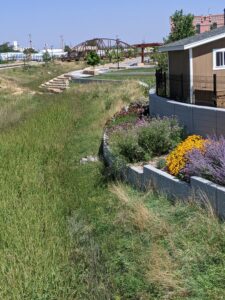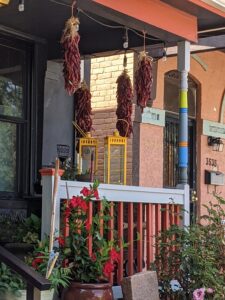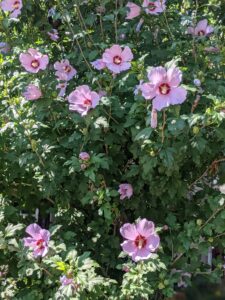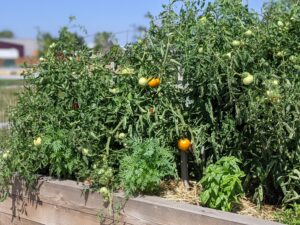The greatest pleasure does not consist in experiencing new things, but in savoring the infinite variation of what we already know.
― Federico Castigliano, Flâneur
Flânerie: the art of strolling
It’s been seven weeks since I last walked north to the Greenway. Too hot. Too much ozone. Too out of town. Today was a window of opportunity: better air, temps around 80°. Tomorrow, 95° and the winds will bring back wildfire smoke. So instead of going to the gym, I walked. My hip wasn’t that happy about it, but it felt good all the same, being out of the house, in sun, blue sky and relatively fresh air. I’m outdoors less in this hot smoky ozone time than I was under pandemic lockdown.
When last I took this twelve-block walk, yards were budding and the Greenway ditch was more dirt and rocks than anything else. The community garden boxes appeared empty. Miracles occur in seven weeks in summer. Young peach trees bend to the ground with their load of ripening fruit, flower gardens spill over fences and community vegetable boxes burst at their seams. The Greenway ditch looks almost lush, or what passes for lush in dry Colorado. Bee-friendly flowers line its borders and a ribbon of water hides beneath tall grasses.
Moving up one block and down another on impulse, there are lovely homes and yards to look at, one with its ristras of red chile and matching red hibiscus, another with a large hibiscus bush. These hardy non-tropical bushes survive winters here, but still evoke my Floridian childhood. I don’t know how long such varieties have existed, but they weren’t in Colorado in my early years here. Seeing their showy blooms always puts me barefoot on sand or climbing moss-hung trees again.
More little bungalows are being pop-topped, more yards turned into container gardens of tomatoes and squash, sunflowers lining the fence. More white people, less brown. I’m saddened to report three more brick homes whose natural red bricks have been painted white, wood trim and window frames black. It is wrong to paint bricks any color, aesthetically and for preservation’s sake. Brick needs to breathe, cannot if painted and may deteriorate. Once painted, it’s hard to undo.
It is especially wrong to paint such houses black and white. Black and white is a nice combination for a tuxedo or a zebra: it is tasteless on a bungalow. After the third such house, I discovered I had started walking at a furious pace, slowed myself down.
On the way back, Manual High students sauntered past, mostly looking tired and glum, weighed down by their backpacks, their burdensome adolescence. It was satisfying to note that residents to the north of me are apparently still predominantly Hispanic. It was the first week of school. Those tired faces were sleep deprived. Besides, one wants a poker face to pass an old white lady, no matter how she smiles. Maybe especially if she smiles. Old white ladies are scary, as every ethnic teenager knows. Or young adults of any race, for that matter. When our young white residents pass my yard with their strollers and dogs, few make eye contact, even if I insist on greeting them.
When I moved here nearly forty years ago, and the neighborhood was mostly black, people sat on their porches, said good afternoon, commented on the weather while I commented on their flowers. Ms. Evelyn Windom had glorious yellow and red tulips in the spring and Ms. Hamilton a splendid red rose bush. Those ladies passed long gone, their houses flipped, those doing the flipping indifferent to the preservation of flora, so the tulips and roses are gone also.
When I got home, my hip was sore, but only the kind of sore that eases with rest. It was refreshing to stroll the neighborhood, to make note of how everything is always changing, for better and for worse. It was good to forget, if only for a few moments, about the origin of this smoke in our air, about hurricanes, about our necessary, messy exit from Afghanistan. It was good to stop grieving about what’s being lost in those places, and pause to see how miracles like tomatoes or hibiscus happen while you’re not looking.





Grieving loss, either of people or places, mores or values, seems a fairly constant experience for us old ones. This is how we know the world will forget us.
Aww, Normando, it is sad, though, isn’t it?
I was raised to believe what you do, Pat, about brick. But as an adult I have come to realize there are beautiful brick homes and ugly brick homes. Our house in Wash Park was the latter. Build as a “mother-in-law” home in the 1920s, it did not have beautiful brick and it had been tuck pointed so many times the cement had dripped over the edges. I used to hate pulling up in front of my own house. It was ugly.
And it’s a moot point anyway, Jana, so many of them, at least in my neighborhood, have been painted, probably often for reasons like yours. But you didn’t paint it black and white, did you? 🙂
Thanks, Pat. Students are the same here—extremely hesitant to look, smile, say good morning on their way to school. I’m so thankful for neighbors who realize how important those small gestures are, and for their dogs who approach without hesitation for a head scratch, a back rub. The teens will get there in time with all the tears and laughter time brings.
The kids are the kids, Bob, and will always be awkward around adults they don’t know.
Always enjoying the small things, Pat. It’s crucial to our survival!
I am lucky to live in a town of about 120,000 in the mountains of North Carolina…People are still friendly here, wave, say “Hi, how are you” and extend the niceties that we experienced when we were growing up. Part of leaving Denver was realizing that life is indeed more restful here. I wish that for all of you as well.
Hola dear Pat, I promise never to paint my bricks! Thanks for the read, I always enjoy these.
Bravo à flânerie!